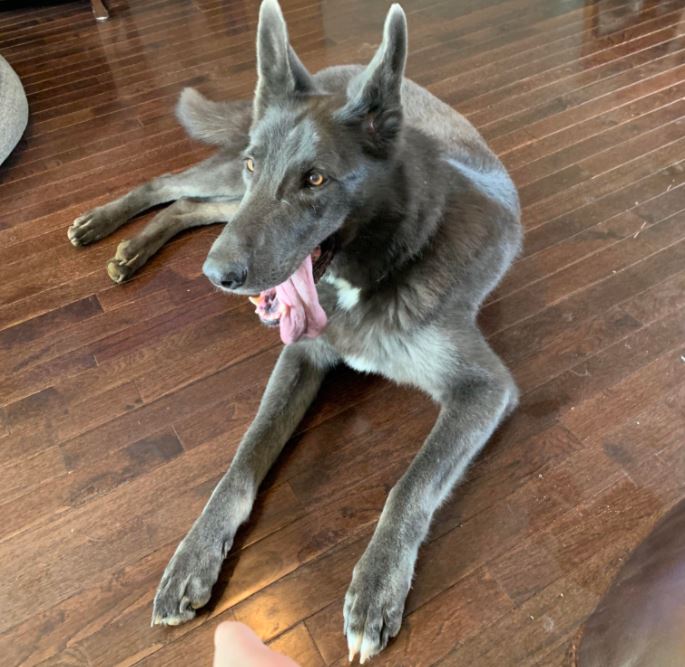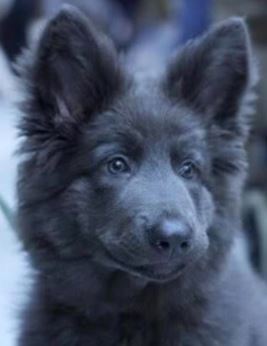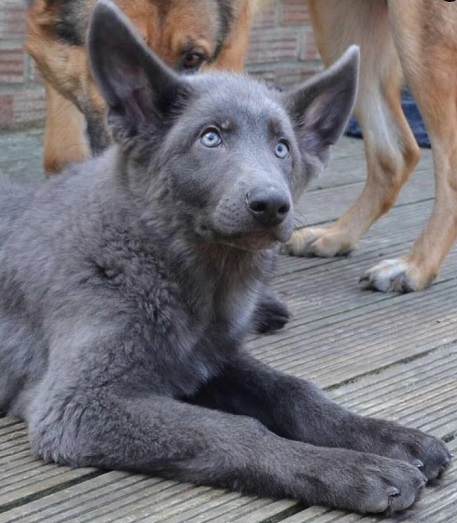Did you know that a Blue German Shepherd Exists? Probably not, since it is rare but an appealing coat color.
The blue German Shepherd dogs get all the awards for appearance but are not popular among people who want a working breed or a show dog as many dog show organizers do not recognize such a coat.
1) Blue German Shepherd With Blue Eyes
Often the blue German Shepherd has both the coat and color of eyes Blue.
The blue color of the coat stays but the same cannot be said about their eyes. Even if a German Shepherd is born with a blue coat and a matching pair of light blue eyes, it may or may not be permanent.
As he grows up, his eyes may become the usual tan or black color. If they do not change, the dog is said to have a recessive gene that dictates their eye color.
2) Blue German Shepherd Dogs are Considered a Defect
A variety of dog organizations and committees consider the blue German Shepherd to be a “fault” or a defect.
This basically means that this particular dog is not the ideal representation of the dog breed. Because of this, blue Shepherd dogs are not accepted in many dog shows.
3) Creating a Blue German Shepherd
A blue coat German Shepherd is not a common color and breed standards do not state this color as part of their standards. Dogs have two genes:
- One decides the color of the hair
- One decides the presence or absence of patterns on the fur
The blue coat color is created when a German Shepherd has two recessive genes. These blue Shepherds are either born randomly in a litter or are specially bred in certain breeding programs.
Sadly, you can also find these appealing dogs in shelters. These German Shepherds are usually surrendered due to their high exercise requirements that cannot be met by some owners.
4) Price of a Blue German Shepherd
The price of a blue German Shepherd starts at $1200 and can go up to $1500.
The price is slightly higher as a blue coat makes them look unique and rarer. Some may mistake him for a wolf!
The general price of the traditional GSD starts at as low as $300 and goes up depending on his genetics and breeder reputation.
Is the dog worth the price? This is a question you must ask yourself if you only want the rarest German Shepherd, second to the White German Shepherd of course.

5) Difference Between Tan, Black, and Blue German Shepherd
Despite his coat, the blue German Shepherd is equally as likely to be adopted as a pet dog as a tan and black variant.
His unique color is easily one of his most likable qualities and many people like this one better than the basic color scheme.
With this odd coloring does not come any difference in character! What you get is the same energetic, courageous, and devoted behavior as with all GSDs.
Teething German Shepherd Puppies – Symptoms and Tips to manage
6) Does Blue Coat Come With Genetic Defects?
Some people may suspect blue coat GSD to have genetic defects. This is not true.
All blue fur means that the gene that is responsible for coat color is a recessive one. This means that the color-specific gene is not dominant.
Apart from the hair (and eyes), all characteristics are the same as the normal coat GSD.
Before buying a blue German Shepherd puppy, make sure the dog has gone through genetic testing to ascertain its future.
Most breeders do not abide by rules and breed dogs for the sake of it. This affects and diminishes the genetic quality of the dog leading to painful suffering.
7) Will a Blue German Shepherd Make a Good Pet?
Yes, all German Shepherds regardless of their coat color make great pets, assuming they are from the companion line.
Some of the GSDs may belong to a working line. These dogs are usually used to round up livestock or carry out certain work since they are able to retain training.
You should check this before getting a GSD as working dogs could have a high prey drive and a high energy drive.
Getting a working GSD for the house is not a good decision!
8) Did You Know There Are 3 Variants of Blue German Shepherds
Blue German Shepherds might not be the solid blue that you may expect. Instead, he will look more like a greyish-blue than true blue.
This blue coat is available in 3 coat color variants:
- Blue and Tan
- Blue and Black
- Blue and Sable

9) How well do they fare in Popularity?
The AKC list of most popular dog breeds in America 2020 places the German Shepherd at number 3!
This means that the GSD beats out many of America’s favorite dog breeds. These include the Poodle, Bulldog, Golden Retriever, Husky, and even the Daschund.
I can understand why every household fantasizes about owning a Shepherd. A true combination of companion and working traits makes them an all-rounder.
10) Is the German Shepherd For You?
Answer the below questions.
- Do you have hours of free time to exercise your dog?
- Do you have the patience for training?
- Do you have a yard?
These are all questions you must ask yourself before you decide on the blue German Shepherd.
These dogs are by no means a “walk in the park”. There is great responsibility in adopting this large dog. Dedicated training and socializing are a reality that cannot be delayed.
Furthermore, this dog can be prone to separation anxiety when alone and aggression when chained up.
They are intelligent, loyal, devoted, and hard-working while they are also loving and protective.
11) Size Matters: How Big Are Blue German Shepherds?
Proceed to adopt this dog only if you have a natural liking for medium to large-sized dogs. Also, get this breed only if you can control and handle them alone! Their size in addition to their energy drive makes them a dog with lots of work and demands.
The male German Shepherd stands at 24 to 26 inches and weighs 65 to 90 pounds. Females stand at 22 to 24 inches and weigh 50 to 70 pounds.
12) Health Issues
All German Shepherd dogs, blue, white, or tan and black are vulnerable to the exact same diseases. No coat color is immune or more at risk of a health issue! As an owner, you should know the symptoms and next steps for such illnesses.
Health issues that may affect your GSD include:
- Hip Dysplasia
- Elbow Dysplasia
- Bloat
- Degenerative Myelopathy
Prior to getting a GSD, test them for hip and elbow dysplasia, an inherited disease that can leave your canine lame and in pain.
13) How Smart is This Dog?
It is true that the German Shepherd is one of the most intelligent dogs around.
This is the reason why humans have utilized this dog so much. The German Shepherd started out like a dog supplying to soldiers during wartime.
Their working capability and intelligence apply in the police and military and even as sniffer dogs in airports. Their softer side makes them useful as therapy and service dogs or even as loyal companions.
14) Hypoallergenic or Not?
Like the traditional German Shepherd, blue German Shepherds are not hypoallergenic.
Owing to their double-coat, this dog will shed profusely twice a year. During these times, you will have to ramp up grooming efforts. Failure to do this will result in dog hair all over your furniture and house.
These hairs can ignite some serious allergies in people prone to dog allergies and immunosuppressed systems.
A dog like this is not advised for such people. You can try a working companion Poodle mix like the Australian Mountain Doodle that sheds less.
Generally, a weekly brush and 6-8 weekly baths are enough to keep them well maintained. During yearly shedding, upgrade the brushing schedule to 2-3 times a week.
15) One-Man Dog
The German Shepherd breed is common for being a “one-man” dog breed. This means he bonds more with one particular person, his main owner. This could be the reason why he makes such a good working dog!
If you are going to get one, make sure you are comfortable with the fact that he will love one particular person more than all the rest! Though with socializing and training, he will gel well with everyone.

